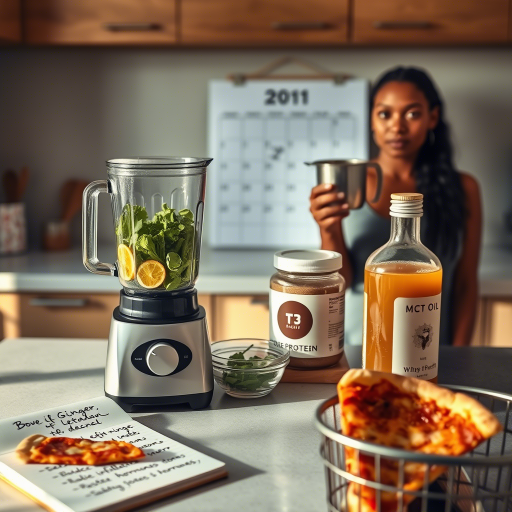
Let’s face it—losing weight can feel like trying to climb a mountain in flip-flops. You’re putting in the effort, but something’s always holding you back. Maybe it’s the cravings that hit like a freight train at midnight. Or the scale that refuses to budge no matter how many salads you choke down. What if the answer wasn’t another grueling diet but something simpler, something…liquid? A liquid diet for rapid weight loss isn’t just a trend—it’s a science-backed reset button for your body. But is it the miracle fix you’ve been searching for, or just another shiny promise? Let’s dive in.
The Science of Liquid Diets: Why They Work (and Why They Don’t)
Liquid diets are like hitting pause on your digestive system. Instead of chewing through a steak or a pile of pasta, you’re sipping on something that’s already broken down—think smoothies, soups, or juices. This gives your gut a break, which sounds nice, right? But it’s not just about rest. When your body isn’t working overtime to digest, it can focus on other things—like burning fat.
Here’s the kicker: not all liquid diets are created equal. Some are basically glorified sugar water (looking at you, store-bought juices). Others? They’re packed with nutrients that can actually heal your body from the inside out. The key is knowing the difference.
The Good, the Bad, and the Ugly of Liquid Diets
Let’s start with the good. A well-planned liquid diet can:
- Boost your metabolism (yes, really).
- Reduce inflammation—that sneaky culprit behind stubborn belly fat.
- Reset your hunger hormones so you’re not constantly battling cravings.
But here’s the bad: if you’re not careful, you could end up feeling like a hangry zombie. And the ugly? Some people gain all the weight back—and then some—the second they stop.
My First Liquid Diet Experience: A Cautionary Tale
I’ll never forget my first attempt at a liquid diet. It was 2018, and I was convinced I’d found the ultimate shortcut. Day one? I felt like a superhero. Day two? I was ready to gnaw my arm off. By day three, I caved and ate an entire pizza. Not my finest moment.
What I learned? A liquid diet isn’t a magic wand. It’s a tool—one that works best when you use it wisely.
The Most Comprehensive Liquid Diet Strategies
If you’re going to try a liquid diet, do it right. Here are a few approaches that actually work:
1. Anti-Inflammatory Green Juices
Think kale, celery, ginger, and a splash of lemon. These aren’t just Instagram-worthy—they’re packed with nutrients that fight inflammation, which is often the root cause of weight gain.
2. Protein-Packed Shakes
Whey or plant-based protein shakes can keep you full and preserve muscle mass. Because let’s be real—no one wants to lose weight just to look like a deflated balloon.
3. Bone Broth Fasts
Bone broth is like a warm hug for your gut. It’s rich in collagen and amino acids, which can heal a leaky gut—a common issue for people who struggle with weight.
4. Ketogenic Elixirs
MCT oil, avocado, and coconut milk can kick your body into ketosis, where it burns fat instead of carbs. Perfect if you’re dealing with insulin resistance.
Why Traditional Diets Fail (and Why Liquid Diets Might Not)
Here’s the thing: most diets fail because they don’t address the root causes of weight gain. Hormonal imbalances, gut issues, chronic stress—these are the real villains. Liquid diets? They can help, but only if you’re targeting the right problems.
For example, cortisol (the stress hormone) can make your body cling to fat like it’s life depends on it. And estrogen dominance? That’s a whole other can of worms. Liquid diets can help reset these imbalances, but they’re not a cure-all.
The Dark Side of Liquid Diets
Let’s not sugarcoat it—liquid diets can be risky. Too long on liquids, and you could lose muscle mass, mess up your metabolism, or even develop nutrient deficiencies. And let’s not forget the psychological toll. Feeling deprived can lead to binge-eating, which is basically the opposite of what you want.
Pro tip: If you’re going to try a liquid diet, keep it short—3 to 7 days max. And for the love of all things holy, don’t skip the protein.
FAQs: Your Burning Questions, Answered
Q: Can I work out on a liquid diet?
A: Sure, but keep it light. Think yoga or walking, not CrossFit. Your body needs energy, and liquids might not cut it for intense workouts.
Q: Will I gain the weight back?
A: Only if you go back to your old habits. Use the liquid diet as a reset, not a free pass to eat whatever you want afterward.
Q: Are liquid diets safe for diabetics?
A: It depends. Some plans (like keto shakes) might help, but others could spike your blood sugar. Always check with your doctor first.
The Future of Liquid Diets: Where Are We Headed?
Liquid diets are having a moment—just look at the rise of brands like Daily Harvest and Sakara. These aren’t your grandma’s meal replacement shakes. They’re gourmet, organic, and designed for people who want results without the sacrifice.
But here’s the thing: trends come and go. What matters is finding what works for you. Maybe that’s a liquid diet. Maybe it’s not. Either way, the goal is the same—feeling good in your skin.
Your Next Steps: Ready to Dive In?
If you’re curious about liquid diets, start small. Try a 3-day green juice cleanse or swap one meal a day for a protein shake. Pay attention to how your body feels. Are you energized? Or are you counting down the minutes until your next meal?
And remember—this isn’t about perfection. It’s about progress. So grab that blender, dust off your juicer, and take the first step. Your future self will thank you.
